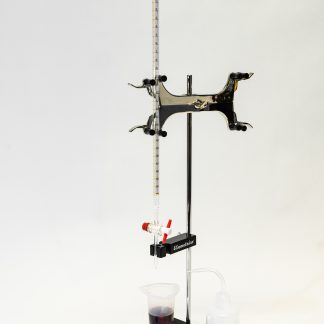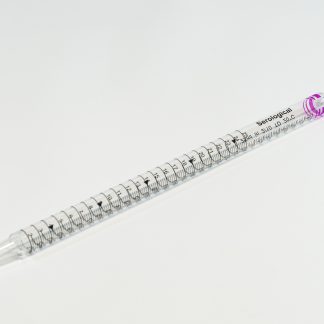Description
Glass burette with either 10 mL titration volume and 0.05 mL gradations or 25 mL titration volume and 0.1 mL gradations. Teflon stopcock. Increases accuracy of titrations for measuring TA, SO2, and Alcohol by Volume. Includes a dry burette detergent and instructions can be found below. Can be secured with a double burette clamp attached to a laboratory support stand. Class A with +/- 0.025 cm3 tolerance.
The teflon stopcock provides a great seal without the need for greasing which makes testing your wine even easier.
This burette makes SO2 and TA titrations easier and imparts higher resolution results for the SC-100A, SC-200 and the SC-300 analyzers. If performing an ABV test, we recommend the 10mL burette for higher accuracy.
Caution: ALWAYS use eye protection and gloves (laytex or nitrile) when using glassware and chemical reagents. We recommend wearing long sleeves, pants and closed toed shoes (no sandals).
Assembly Instructions
Carefully take the burette out of the tube and remove the bubble wrap and packing material. Attached to the burette is a small bubble wrapped bag with the Teflon stopcock inside and the Burette Detergent. Unwrap the bag from the burette and then remove the Teflon stopcock from the bag. The stopcock has a red screw cap, a black rubber gasket and a red washer attached, remove these temporarily and then place the Teflon stopcock inside the gap in the burette. It should fit snug. Then place the red washer on the end of the threaded part of the stopcock which is protruding through the gap of the burette. Then put the rubber gasket on followed by screwing on the red screw cap so it is hand tight. Now you are ready to titrate!
Burette Maintenance
Keep the burette clean and wash with deionized (distilled) water when you are finished using the burette. This is especially important for TA titrations because the TA Titrant is particularly prone to causing the teflon stopcock to etch. Every so often you will want to clean your burette with a cleaning solution to maintain accuracy of the burette. The included 2 grams of Burette Detergent is specially formulated to clean glassware. The detergent ships in an Eppendorf tube that has gradations of ~ half a gram. Upon first receiving the detergent, mix approximately half a gram (about a quarter of the tube) with about 50 mililiters (mL) of deionized water in a small bottle. We recommend capping the bottle and shaking well for a minute or until the detergent is dissolved. Bubbles may form but the detergent will still be effective. The detergent solution should be made fresh every time you clean the burette, as it loses its potency if stored as a liquid. After you have run deionized water through your burette, close the stopcock, and fill with the Burette Detergent solution. You can open and close the stopcock over a waste bucket or sink to allow the solution to pass into the tip of the stopcock. We recommend letting this detergent solution sit in the burette for one hour. Dispense the detergent solution then rinse the burette with deionized water twice more. During this time we recommend opening and closing the stopcock to make sure the stopcock is turning easily. If it is not, remove the stopcock and clean it thoroughly. Once drained, allow to hang dry by hanging the burette upside down with the stopcock in the open position. Once the burette is dry cover the top opening with a piece of tape. This will prevent dust from getting in that can cause aberrations when reading the burette. Remove the tape when you’re ready to titrate.
Burette Reading
To get the most accurate results when titrating, there are a few things to keep in mind. First, use a thick sheet of white paper or a notecard, and draw a thick black band down the center of the paper with a width of about an inch and a half. When taking a measurement, hold the paper about an inch behind the burette and the band about a half an inch below the meniscus. This provides a clear view of the bottom of the meniscus which helps make an accurate, consistent measurement. Second, when filling the burette make sure the titrant (in most cases this will be either the SO2 Titrant or the TA Titrant) has completely filled the bottom of the burette down to the tip. In fact, we recommend running a bit of the titrant you are using through the burette to remove any contaminants that may remain from a previous titration. Finally, make sure there are not any large bubbles in the burette after filling. If there are, cover the top of the burette with some saran wrap (or parafilm if you have it), make sure the stopcock is in the closed position, take the burette out of its clamp and hold the saran wrapped end tightly. Rotate and invert the burette to allow the bubbles to move out of the column of titrant. Once the bubbles have been displaced, you are nearly ready to titrate. Before beginning the titration, record the starting titration volume, using the white paper with the black band, and then begin titrating, slowly. Record the final titration volume using the same technique.
For more info
You can also checkout Burette info here or a great guide here.
Laboratory support stand and Double Burette Clamp sold separately.








